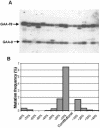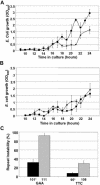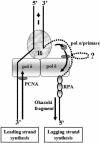Replication-mediated instability of the GAA triplet repeat mutation in Friedreich ataxia
- PMID: 15534367
- PMCID: PMC528813
- DOI: 10.1093/nar/gkh933
Replication-mediated instability of the GAA triplet repeat mutation in Friedreich ataxia
Abstract
Friedreich ataxia is caused by the expansion of a polymorphic and unstable GAA triplet repeat in the FRDA gene, but the mechanisms for its instability are poorly understood. Replication of (GAA*TTC)n sequences (9-105 triplets) in plasmids propagated in Escherichia coli displayed length- and orientation-dependent instability. There were small length variations upon replication in both orientations, but large contractions were frequently observed when GAA was the lagging strand template. DNA replication was also significantly slower in this orientation. To evaluate the physiological relevance of our findings, we analyzed peripheral leukocytes from human subjects carrying repeats of similar length (8-107 triplets). Analysis of 9400 somatic FRDA molecules using small-pool PCR revealed a similar mutational spectrum, including large contractions. The threshold length for the initiation of somatic instability in vivo was between 40 and 44 triplets, corresponding to the length of a eukaryotic Okazaki fragment. Consistent with the stabilization of premutation alleles during germline transmission, we also found that instability of somatic cells in vivo and repeats propagated in E.coli were abrogated by (GAGGAA)n hexanucleotide interruptions. Our data demonstrate that the GAA triplet repeat mutation in Friedreich ataxia is destabilized, frequently undergoing large contractions, during DNA replication.
Figures







Similar articles
-
The GAA triplet-repeat sequence in Friedreich ataxia shows a high level of somatic instability in vivo, with a significant predilection for large contractions.Hum Mol Genet. 2002 Sep 1;11(18):2175-87. doi: 10.1093/hmg/11.18.2175. Hum Mol Genet. 2002. PMID: 12189170
-
Expansion of GAA triplet repeats in the human genome: unique origin of the FRDA mutation at the center of an Alu.Genomics. 2004 Mar;83(3):373-83. doi: 10.1016/j.ygeno.2003.09.001. Genomics. 2004. PMID: 14962663
-
Replication in mammalian cells recapitulates the locus-specific differences in somatic instability of genomic GAA triplet-repeats.Nucleic Acids Res. 2006;34(21):6352-61. doi: 10.1093/nar/gkl846. Epub 2006 Nov 16. Nucleic Acids Res. 2006. PMID: 17142224 Free PMC article.
-
Replication dependent and independent mechanisms of GAA repeat instability.DNA Repair (Amst). 2022 Oct;118:103385. doi: 10.1016/j.dnarep.2022.103385. Epub 2022 Aug 3. DNA Repair (Amst). 2022. PMID: 35952488 Free PMC article. Review.
-
[Friedreich ataxia with GAA repeat expansion: molecular mechanism and clinical feature].Nihon Rinsho. 1999 Apr;57(4):960-6. Nihon Rinsho. 1999. PMID: 10222797 Review. Japanese.
Cited by
-
The Regulation of the Disease-Causing Gene FXN.Cells. 2024 Jun 15;13(12):1040. doi: 10.3390/cells13121040. Cells. 2024. PMID: 38920668 Free PMC article. Review.
-
Effects of Friedreich's ataxia (GAA)n*(TTC)n repeats on RNA synthesis and stability.Nucleic Acids Res. 2007;35(4):1075-84. doi: 10.1093/nar/gkl1140. Epub 2007 Jan 30. Nucleic Acids Res. 2007. PMID: 17264130 Free PMC article.
-
Paradigm for disease deconvolution in rare neurodegenerative disorders in Indian population: insights from studies in cerebellar ataxias.J Genet. 2018 Jul;97(3):589-609. J Genet. 2018. PMID: 30027898
-
Chromosome fragility at GAA tracts in yeast depends on repeat orientation and requires mismatch repair.EMBO J. 2008 Nov 5;27(21):2896-906. doi: 10.1038/emboj.2008.205. Epub 2008 Oct 2. EMBO J. 2008. PMID: 18833189 Free PMC article.
-
Response to Falush: a role for cis-element polymorphisms in HD.Am J Hum Genet. 2009 Dec;85(6):942-5. doi: 10.1016/j.ajhg.2009.11.006. Am J Hum Genet. 2009. PMID: 20004773 Free PMC article. No abstract available.
References
-
- Campuzano V., Montermini,L., Moltó,M.D., Pianese,L., Cossée,M., Cavalcanti,E., Monrós,F., Rodius,F., Duclos,F., Monticelli,A. et al. (1996) Friedreich's ataxia: autosomal recessive disease caused by an intronic GAA triplet repeat expansion. Science, 271, 1423–1427. - PubMed
-
- Bidichandani S.I. and Ashizawa,T. (2002) Friedreich ataxia, GeneReviews: Genetic Disease Online Reviews of GeneTests-GeneClinics. Copyright University of Washington, Seattle, WA, USA.
-
- Montermini L., Andermann,E., Labuda,M., Richter,A., Pandolfo,M., Cavalcanti,F., Pianese,L., Iodice,L., Farina,G., Monticelli,A. et al. (1997) The Friedreich ataxia GAA triplet repeat: premutation and normal alleles. Hum. Mol. Genet., 6, 1261–1266. - PubMed
Publication types
MeSH terms
Substances
Grants and funding
LinkOut - more resources
Full Text Sources
Medical
Miscellaneous

